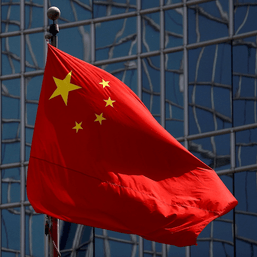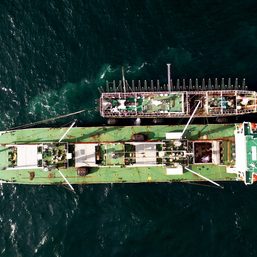SUMMARY
This is AI generated summarization, which may have errors. For context, always refer to the full article.
![[In This Economy] How can the PH economy become less reliant on China?](https://www.rappler.com/tachyon/2023/12/TL-PH-economy-less-reliant-china-December-19-2023.jpg)
The short answer is that it’s easier said than done.
With rising tensions in the West Philippine Sea, there’s increasing talk now of the Philippines becoming less dependent on the Chinese economy – as a signal that we’re not tolerating China’s illegal incursions in our very own backyard.
Most recently, law professor and maritime law expert Jay Batongbacal said in an interview with state television network PTV that even if we import lots of consumer goods from China, we can instead import them from other countries.
He added, “Magkakaroon ng adjustment siyempre, at medyo magkakaroon din ng kaunting sakit. Pero ang punto doon eh, bakit tayo magpapatakot sa kanila? So kung kailangang tiisin natin ang kaunting inconvenience, eh gawin natin. ’Yun ang paraan para ipakita natin sa kanila na maninindigan talaga tayo sa ating mga karapatan.” (There will be adjustments, of course, and some pain. But the point is, why should we cower? If we need to endure some inconvenience, let’s do it. That’s the way to show China we’re standing up for our rights.)
But just how reliant are we on China? Let’s look at some basic stats from 2022.
Exports and imports
Over the years, China has emerged to become the Philippines’ largest trading partner.
Figure 1 shows that our total trade with them was more than $39 billion in 2022, or roughly more than P2.1 trillion. That’s 18% or nearly a fifth of total trade, and almost as large as 40% of the Philippine government’s budget in that year.
Let’s break this down.
China was the third largest destination of our exports, next to the US and Japan. Merchandise exports to China totaled almost $11 billion, or about P600 billion. That’s 14% of total exports.
China figures much more heavily when it comes to imports. More than a fifth of all our imports came from China. That’s $28.22 billion: more than P1.5 trillion or nearly 30% of the government’s budget in that year.
Indeed, China was our top source of imports in 2022. China’s share in total imports was more than the combined shares of the next two countries on the list, Indonesia (9.6%) and Japan (9%).
Figure 1.
Because we import so much from China and export too little to them, our largest bilateral trade deficit is naturally with them (Figure 2). We imported more than $17 billion from them than we exported to them.
Figure 2.
All said, our trade with China is nothing to sneeze at. If we had suddenly lost all trade to China in 2022, we would have lost about P2.1 trillion in economic activity. It’s not easy to replace that amount. Many consumer groups and industries will be crippled. And research also shows that in developing countries such as ours, a stable inflow of imports are crucial to ensure future growth.
What exactly do we export to and import from China?
Still looking at 2022, our top 5 exports to China were “electronic products,” “other mineral products,” “cathodes and sections of cathodes, of refined copper,” “other manufactured goods,” and “fresh bananas” (see Figure 3).
Meanwhile, our top imports from China were “electronic products,” “iron and steel,” “mineral fuels, lubricants and related materials,” “industrial machinery and equipment,” and “miscellaneous manufactured articles.”
Figure 3.
You may notice that our top exports from China are also our top imports from them. This is emblematic of the overall trade structure of the Philippines. It points to the fact that where electronic products are concerned, we import so much of them, assemble them in the country, then ship them out again for final processing before they’re turned into final products like laptops or smartphones.
In short, our export manufacturing sector in the country has very low value-added, and we need to shift to the production of goods with higher value-added. That’s been a challenge for the longest time.
At any rate, if we’re going to cut economic ties with China, we will need to look for alternative sources of electronic products, iron and steel, fuels and lubricants, machinery and equipment, etc. At the same time, we need to find new markets for our electronic components, copper cathodes, and bananas.
Professor Batongbacal made the point that some of our exports, including electronic components, are possibly (or even likely) being used to develop and produce ships and planes being used in their incursions into the West Philippine Sea. That’s certainly unconscionable.
But what is the exact proportion of our exports going into China’s weapons or military production? Is it 1%? 5%? 20%? To date, we don’t really know. And substantially reducing or even banning all trade with China based on this unknown figure may be too much of a cost for Filipino consumers and industries reliant on otherwise cheap and useful Chinese goods.
Foreign direct investments
Another way we rely on the Chinese economy is through net foreign direct investments. But here, China plays a smaller role.
In 2022, based on data from the Bangko Sentral ng Pilipinas, China accounted for less than 1% of foreign direct investments or FDIs (specifically, new equity investments). Our largest source was the ASEAN bloc (37%), followed by Japan (35%), and North America as a far third (13.7%).
When you look at the trend of FDIs from China (Figure 4), there was but a small bump in 2018 and 2019, where its share rose to 8.5% and 12% in those two years, respectively. But otherwise, China’s share has been small; the yearly average from 2005 to 2019 was merely 1.7%.
Figure 4.
Even China’s Belt and Road Initiative (BRI) projects petered out in the Philippines. Back in 2016, China had pledged about $9 billion in projects. But by late 2019, only about 10% of that had materialized.
Come to think of it, the promised $9 billion in BRI projects isn’t so hefty after all. Last year, we paid more than thrice that amount for goods we bought from China.
Just this year, China is reportedly pulling back its planned investments in the Philippines in earnest. They stopped funding for the Mindanao Railway Project (Phase 1), partly owing to “geopolitical factors” according to one Chinese official.
In a way, then, China is voluntarily decoupling from us just as we are thinking of decoupling from them.
During the Duterte years, more Chinese investments came by way of online gambling operations (otherwise known as Philippine online gambling operations or POGO).
Although POGO generated some economic activity in the country (from Filipinos hired as employees to restaurants catering to Chinese immigrant workers), the addition to total production or gross domestic product (GDP) was but small: just 0.6-0.7% in 2019, according to the National Economic and Development Authority, and down to about 0.3% in 2023.
At the same time, POGO caused so many problems by way of social disruption and crimes such as money laundering and even prostitution and torture.
What about Filipinos’ foreign investments in China?
Teresita Sy-Coson of SM Investments recently issued a statement cautioning against antagonizing China. She said, “China is very close to us, we cannot be too antagonistic. Even though we know what is happening, I guess we have to do it through a more peaceful negotiation.”
Sy-Coson added, “I think we have to look at our own position. We don’t want to get involved in the US-China tensions. What we have to do is to have peaceful discussions with them because, after all, we can’t change our neighbors.”
Apart from the fact that SM has malls in China, Bloomberg also reported that Sy-Coson’s brother Henry Sy Jr. “owns a stake” in the National Grid Corporation of China, 40% of which is owned by the State Grid Corporation of China.
If we sever economic relations with China, what does that mean for big businesses like SM currently investing in China? The fact that Sy-Coson has already been compelled to make a statement – as early as now – shows just how large the stakes are for them and other companies.
Hypocrisy
There are other ways we get money from China, but they’re not so notable. For instance, in 2022 we got less than $23 million in terms of remittances (just 0.07% of all remittances), and Chinese air visitors accounted for less than 1.5% of air visitors.
The biggest link, bar none, is through trade. With China bullying us for years (and more aggressively so in recent weeks), I agree with Professor Batongbacal that we need to rethink our economic reliance on China.
We can’t continue paying billions of pesos worth of imports to them (think of our $17 billion trade deficit with them last year) while they’re bombarding us with water and ramming our ships in the West Philippine Sea. That’s rather hypocritical, akin to paying money to someone who stabs your back.
But the big challenge is to look for substitute trading partners, specifically sources for key imports and consumer goods. Will our supporters in the West Philippine Sea step up and open the doors to do more trade with us? – Rappler.com
JC Punongbayan, PhD is an assistant professor at the UP School of Economics and the author of False Nostalgia: The Marcos “Golden Age” Myths and How to Debunk Them. JC’s views are independent of his affiliations. Follow him on Twitter (@jcpunongbayan) and Usapang Econ Podcast.
1 comment
How does this make you feel?






![[ANALYSIS] To the moon and beyond the headlines: Asia’s good to bad, 2023](https://www.rappler.com/tachyon/2023/12/tl-asia-good-bad-2023.jpg?resize=257%2C257&crop_strategy=attention)







![[Just Saying] SONA 2024: Some disturbing points](https://www.rappler.com/tachyon/2024/07/TL-marcos-sona-points-july-23-2024.jpg?resize=257%2C257&crop=335px%2C0px%2C720px%2C720px)

Thanks to both Prof. JC Punongbayan and Prof. Jay Batongbacal. Will President Marcos Jr. heed the idea of “rethink(ing) our economic reliance on China”? More likely NOT, if the Sy Family of SM and other Filipino-Chinese Billionaires have contributed a lot to his 2022 Presidential Campaign Fund.